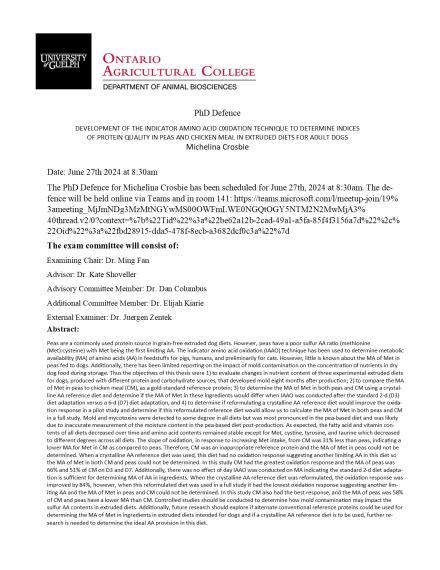Michelina Crosbie's PhD Defence
Date and Time
Location
Room 141 and teams: https://teams.microsoft.com/l/meetup-join/19%3ameeting_MjJmNDg3MzMtNGYwMS00OWFmLWE0NGQtOGY5NTM2N2MwMjA3%40thread.v2/0?context=%7b%22Tid%22%3a%22be62a12b-2cad-49a1-a5fa-85f4f3156a7d%22%2c%22Oid%22%3a%22fbd28915-dda5-478f-8ecb-a3682dcf0c3a%22%7d

Details
Title: DEVELOPMENT OF THE INDICATOR AMINO ACID OXIDATION TECHNIQUE TO DETERMINE INDICES OF PROTEIN QUALITY IN PEAS AND CHICKEN MEAL IN EXTRUDED DIETS FOR ADULT DOGS
Abstract:
Peas are a commonly used protein source in grain-free extruded dog diets. However, peas have a poor sulfur AA ratio (methionine (Met):cysteine) with Met being the first limiting AA. The indicator amino acid oxidation (IAAO) technique has been used to determine metabolic availability (MA) of amino acids (AA) in feedstuffs for pigs, humans, and preliminarily for cats. However, little is known about the MA of Met in peas fed to dogs. Additionally, there has been limited reporting on the impact of mold contamination on the concentration of nutrients in dry dog food during storage. Thus the objectives of this thesis were 1) to evaluate changes in nutrient content of three experimental extruded diets for dogs, produced with different protein and carbohydrate sources, that developed mold eight months after production; 2) to compare the MA of Met in peas to chicken meal (CM), as a gold-standard reference protein; 3) to determine the MA of Met in both peas and CM using a crystalline AA reference diet and determine if the MA of Met in these ingredients would differ when IAAO was conducted after the standard 2-d (D3) diet adaptation versus a 6-d (D7) diet adaptation, and 4) to determine if reformulating a crystalline AA reference diet would improve the oxidation response in a pilot study and determine if this reformulated reference diet would allow us to calculate the MA of Met in both peas and CM in a full study. Mold and mycotoxins were detected to some degree in all diets but was most pronounced in the pea-based diet and was likely due to inaccurate measurement of the moisture content in the pea-based diet post-production. As expected, the fatty acid and vitamin contents of all diets decreased over time and amino acid contents remained stable except for Met, cystine, tyrosine, and taurine which decreased to different degrees across all diets. The slope of oxidation, in response to increasing Met intake, from CM was 31% less than peas, indicating a lower MA for Met in CM as compared to peas. Therefore, CM was an inappropriate reference protein and the MA of Met in peas could not be determined. When a crystalline AA reference diet was used, this diet had no oxidation response suggesting another limiting AA in this diet so the MA of Met in both CM and peas could not be determined. In this study CM had the greatest oxidation response and the MA of peas was 66% and 51% of CM on D3 and D7. Additionally, there was no effect of day IAAO was conducted on MA indicating the standard 2-d diet adaptation is sufficient for determining MA of AA in ingredients. When the crystalline AA reference diet was reformulated, the oxidation response was improved by 84%, however, when this reformulated diet was used in a full study it had the lowest oxidation response suggesting another limiting AA and the MA of Met in peas and CM could not be determined. In this study CM also had the best response, and the MA of peas was 58% of CM and peas have a lower MA than CM. Controlled studies should be conducted to determine how mold contamination may impact the sulfur AA contents in extruded diets. Additionally, future research should explore if alternate conventional reference proteins could be used for determining the MA of Met in ingredients in extruded diets intended for dogs and if a crystalline AA reference diet is to be used, further research is needed to determine the ideal AA provision in this diet.